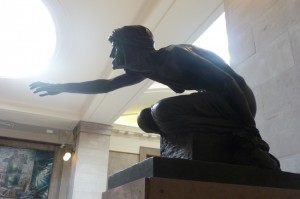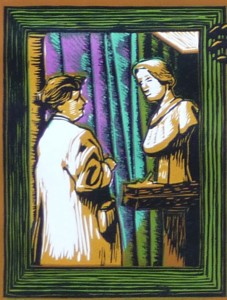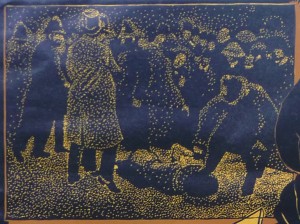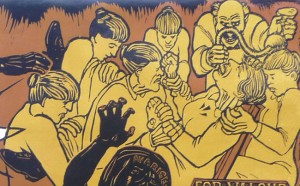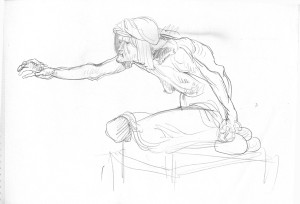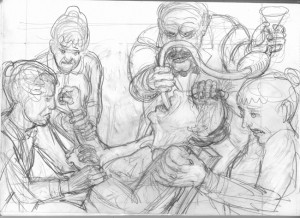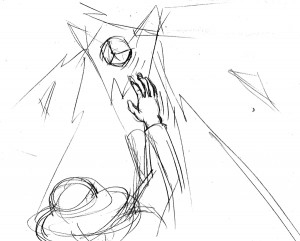I became interested in the sculptor Edith Downing (1857 – 1931) when I first visited the National Museum of Wales in 1996.
Mounted on the south-west staircase in the museum’s entrance hall is a dark bronze sculpture of a semi-naked woman, called ‘Avarice’, dated 1908, made by a woman sculptor whose work was new to me. The haggard figure reminded me of Donatello’s wood-carved ‘Magdalen’ that had shocked and amazed me when I had first seen it in the Baptistry of Florence Cathedral thirty years earlier. My first attempts to learn more about the artist were unsuccessful, but in the final year of my research degree at Cardiff University, the museum offered assistance to students who might wish to deliver a talk about a work in the museum’s collection. I responded, and the Collections Manager, Clare Smith sent me the list of eight works which the artist had donated in 1930, together with a few facts about her life, including a mention that she had been a suffragette.
I now began to research her life. I was helped by Beverley Cook, archivist of the Suffragette Collection at the Museum of London who emailed the photograph of Downing at work in her studio, which I adapted in the print. Beverley Cook also directed me to the very helpful University of North London’s Women’s Library for their microfilm collection of the Votes for Women newspaper, and for Elizabeth Crawford’s indispensable book, The Women’s Suffrage Movement, A Reference Guide 1866-1927.
Edith Downing was born in Cardiff, the third daughter of a ship-broker. She was taught at Cheltenham Ladies’ College and Cardiff School of art before going on to study in London and then Paris, where she exhibited at the Salon. On her return, she showed at the Royal Academy, throughout Britain and as far away as New Zealand.
Involved with the Suffrage movement since 1903, in 1908 she joined the Chelsea branch of the Women’s Social and Political Union (WSPU), the most militant suffragette organisation, with the Pankhursts as leading figures. Her own deeper radicalisation, however, dates from ‘Black Friday’ when women were criminally manhandled by police during an otherwise peaceful protest outside Parliament. Downing herself later claimed she nearly lost her life on ‘Black Friday’, though the cause celebre in the press was a Miss Ada Wright who was repeatedly cast to the ground by police. A tall man, wearing a top hat, had tried to come to her aid, but was bundled away by the constables.
The Suffragettes’ political anger had been intensified in 1910 by Prime Minister Asquith’s betrayal, as they saw it. A Bill had been passed giving limited suffrage to women with property, but he failed to enact it. A second insult to their habitual pacifism had been an unguarded remark by a government minister, that women were less serious in their struggle for the vote, compared to men, who in their campaign had burnt down a castle and pulled up the railings in Hyde Park. On 1st of March 1912, Edith Downing was arrested for breaking the windows of an a Regent Street Fine Art dealer. She had been a ring-leader, on record for providing the cobblestones for a small group of window-smashers.
On 26th March, she was fined the full cost of the glass, £26, and also sentenced to six months in Holloway Prison, where she joined the hunger strikers’ campaign for the status of political prisoner, suffering the painful practice of force-feeding, which was in fact illegal if prisoners were of sound mind.

For her sufferings in resisting force-feeding, Edith Downing was awarded the WSPU’s Hunger Strike Medal.
By this time, Edith Downing had become a prominent artist leader of the WSPU. She was one of many amateur and professional artists who used their talents, nurtured by the Academies and the Arts and Crafts movement, to further the cause. Items of jewellery were a popular fund-raising means that also spread the ‘message’, and the design on one such ‘Votes For Women’ enamel brooch provided me with a motif for the fictitious banner in this print.  Edith Downing donated bronzes to raise funds, and was prominent as one of the designers of processions and political tableaux that were part of the peaceful demonstrations that converged on Hyde Park, attracting delegates and journalists from all over the UK and the world. The procession depicted in this linocut print is based on photographs on the Museum of London website, together with photographs in Votes for Women. The ‘Prison to Citizenship’ parade of 18th June 1910 was reported on p 628 of the paper’s 24th June issue: “One tableau in the procession was supplied by the girls’ contingent, and was very striking. It was arranged by Miss Wallace Dunlop and Miss Downing. Clad in pure white and wearing caps of green and violet, the girls, ranging from 13 to 20 years, typified the devotion and thanks of the younger generation to those who had suffered in the cause of women”.
Edith Downing donated bronzes to raise funds, and was prominent as one of the designers of processions and political tableaux that were part of the peaceful demonstrations that converged on Hyde Park, attracting delegates and journalists from all over the UK and the world. The procession depicted in this linocut print is based on photographs on the Museum of London website, together with photographs in Votes for Women. The ‘Prison to Citizenship’ parade of 18th June 1910 was reported on p 628 of the paper’s 24th June issue: “One tableau in the procession was supplied by the girls’ contingent, and was very striking. It was arranged by Miss Wallace Dunlop and Miss Downing. Clad in pure white and wearing caps of green and violet, the girls, ranging from 13 to 20 years, typified the devotion and thanks of the younger generation to those who had suffered in the cause of women”.
From ‘Museum Talk’ to Linocut
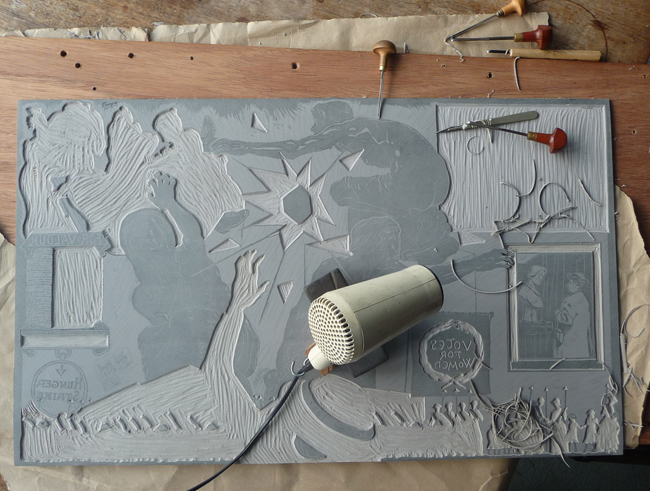
Unfinished block being cut to print the violet. The print’s overall composition, visible here in grey, was off-set from a ‘wet’ print taken from the key block. This was repeated with a fresh block for each colour. This ‘off-set’ process is shown at the top of the Home Page of this website.
My research into the life of Edith Downing had graduated from curiosity to admiration, with a growing sense that here was an artist whose reputation seemed to have faded, undeservedly. By the time I had enough material for a talk, I had already finished my degree and no longer fitted the museum’s criteria for giving talks.
My imagination was by now working on a print for an artists’ group exhibition called VOGA Exposed, curated by three participants: Shirley Anne Owen, Kay Keogh and Jean Francis. This is how they explained their aims for the show: “Bringing the studio into the gallery reveals the artists’ varied working practices. The rarely seen evidence of the process from concept to final resolution is exposed.” Each artist wrote an individual explanatory panel and I also wrote a blog about the whole exhibition.
I had a subject I was passionate about, and began work, documenting the process as the print developed. At this period VOGA also used to organise visits to the prints and drawings collection at the National Museum of Wales. Once, Beth McIntyre, the curator, showed us a magnificent collection of drawings by Eric Gill and David Jones. She showed us both early drawings of extreme, taught precision, and also later paintings by David Jones in watercolour over delicate pencil traceries. One in particular, Tristan ac Essylt, astonished me. It was large, ambitious, bursting with ideas, pictures within pictures, changes of scale, all organised within a strong composition. This was the kind of imagery to which I was beginning to aspire, and here was an exemplar which showed me the way.
In addition to making some preliminary sketches, I had gained copyright permission from the museum to take photographs of Avarice, as I was working on this print.
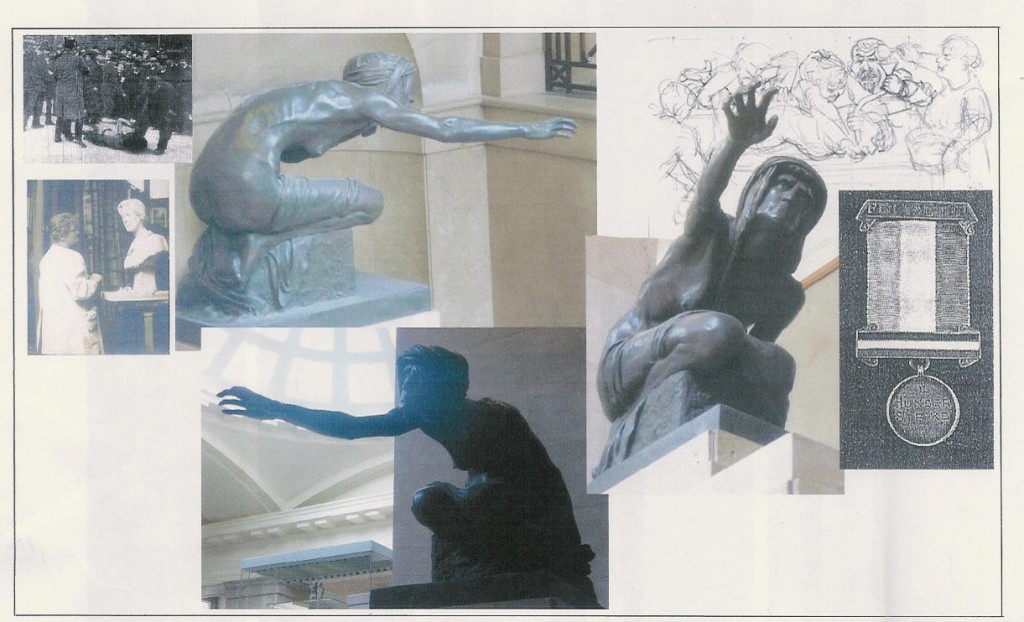
A computer-assisted compositional study, using a scanner, Adobe Photoshop and Microsoft Publisher. At this early stage, I wrongly imagined the victim being held down on a bed.
Because I knew that it had been an Art Gallery’s windows that Edith Downing had smashed, the idea came to me of showing three castings of Avarice, her Cardiff masterpiece, from different angles. The anguished, repeated grasping of the right hand had the potential to set up a rhythmic movement that expressed her suffering and unified the composition.
When I saw contemporary illustrations of the force-feeding of Suffragettes, it became clear that the victim was held down in a chair that was tipped back. I made several attempts to make this corner of the print an accurate account of her ordeal. There is an echo here of the sufferings of saints and martyrs in Christian art.
Having visualised three copies of Avarice in the window of an Art Dealer, it seemed another unifying step to depict the window as the glass which Edith Downing smashed. Her cobblestone does not smash only the glass, but also the picture plane, placing Edith Downing in front of it. Only a few steps later, with scanner, software, printer and pencil, the design was complete.
This photograph shows the three dimensional aspect of carved relief printing which appeals to that side of my artistic personality which is in love with sculpture.
I reduced the size of hand of the Avarice which is facing us, compared to its size in the photograph, to keep it behind the picture plane (and the window).
Apart from the balancing of the two rectangles already mentioned (portrait and medal ribbon), I was very conscious of the two historic acts of violence at the top, left and right, expressed also in the pattern of hands, brought to a climax in the cobble-throwing hand of Edith Downing herself.
 I was also very conscious of the circular rhymes between the dangling medal and the angled head of the ‘Avarice’ facing us, the rounded forms of Edith Downing’s hat and the round motif of the banner’s wreath. While working on the print, I consciously harnessed the violet, green and white to unify the composition and heighten its impact. For this reason, I did not use the violet, green and white descriptively in the Suffragette procession, apart from in the banner, as this would have dissipated the impact of those colours where they mattered most in the print.
I was also very conscious of the circular rhymes between the dangling medal and the angled head of the ‘Avarice’ facing us, the rounded forms of Edith Downing’s hat and the round motif of the banner’s wreath. While working on the print, I consciously harnessed the violet, green and white to unify the composition and heighten its impact. For this reason, I did not use the violet, green and white descriptively in the Suffragette procession, apart from in the banner, as this would have dissipated the impact of those colours where they mattered most in the print.


